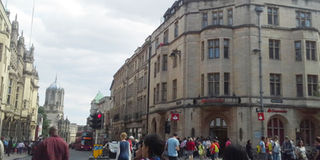Walking the footsteps of great men

A street in Oxford is complete with tourists from different parts of the world. PHOTO BY BRIAN MUTEBI
Anyone who can read and write has come across a book printed by the Oxford University Press. Such is the legacy this university enjoys.
Yet many have but only a mental picture of the city where this giant publishing company established in 1586 is located.
I was there. Located on the upper reaches of the River Thames at its junction with the River Cherwell, Oxford is an ancient city founded in 912 AD. However, the city still carries huge significance today not only in the United Kingdom or Europe but across the world.
That piece of global significance is inextricably tangled with the existence in the city of a global reputable institution, the University of Oxford.
The famous Oxonians
The university has produced men and women of global repute.
The Famous Oxonians as they are referred to, include among them 26 British prime ministers such as Tony Blair and David Cameroon; at least 30 international leaders such as former US president Bill Clinton; 50 Nobel Prize winners such as Baruch S. Blumberg, the Nobel Prize-winning biochemist and medical anthropologist who discovered the Hepatitis B virus, and 120 Olympic medal winners.
The other famous Oxonian is Sir Tim Berners-Lee, inventor of the World Wide Web. That is the reputation that the city and the University of Oxford enjoy.
Where the great walked
I walked around the square, the famous University of Oxford Square where great men and women walked as they pursued their studies that would later impact the world immensely.
Strolling on the narrow streets of this ancient city with old beautiful architecture was a memorable adventure. In fact besides academics, architecture is what perhaps defines Oxford city.
Standing out tall is the 12th Century building of the University Church of St Mary the Virgin. Believers met therein from at least 1252 AD. It was adopted as the first building of the university and by the 13th Century, it was the seat of university administration used for lectures and the award of degrees.
Marveling piece of architecture
The church’s well-decorated pyramidal structure with triple triangular intersecting edges at the top, outer and inner pinnacles and effigies, is a marvel. Its interior space has six-bay galleries with shafted piers.
Between the high wall windows are canopied niches with archangels holding shields. The roof has well decorated curved and triangular arches.
The Sedilia (seats) on the liturgical south side of the altar are made of beautiful stones decorated with cusped arches and a strip of vine leaves, not to mention the glittering chancel (space around the altar). The pews are made of smooth pieces of wood.
You would not compare them with those found in St Paul’s Cathedral Namirembe but the design and arrangement is not so different.
Shopping and leisure
The city is full of tourists who flock it daily, no wonder Oxford is one of the most expensive cities in the UK. Shopping centres such as Westgate and Primark are busy with residents and tourists.
I saw a man in the parking yard pack his vehicle with items after shopping and it seemed he was going to open a retail shop in his home!
Outside the city centre are green parks such as Tilsley Park for leisure and recreation.
On Sundays, I attended church, some typical English churches while others had a mix of English and African music. The praise and worship session at Pearly Gates Church for example, was not much different from the one we always have at Makerere Full Gospel Church involving jumping and dancing for the Lord.
After tight schedules on my trip involving speaking in various fora, I often relaxed at Tilsley Park. It was a refreshing working holiday. The pictures I took give me a feeling of satisfaction and great memories for Oxford, a city where the ancient brightens the present, and perhaps will do so for many years to come.
Interesting facts about Oxford city
-Oxford was once the capital of England during the English Civil War in 1642.
-The name Oxford comes from the old term ‘Oxanforda’ which literally meant a ford (shallow crossing) in the river where the cattle (Oxen) could cross safely
-Residents and natives of Oxford are known as Oxonians
-The bell in the tower of Christ Church Cathedral in the city is called the Old Tom which strikes a unique 101 times at 9.05pm every evening.
-Oxford has more published writers per square mile than anywhere else in the world.
-One of Oxford popular publications is the Oxford English Dictionary
-Hitler intended to use Oxford as his capital if he conquered England which is one of the reasons it was not bombed during World War II




